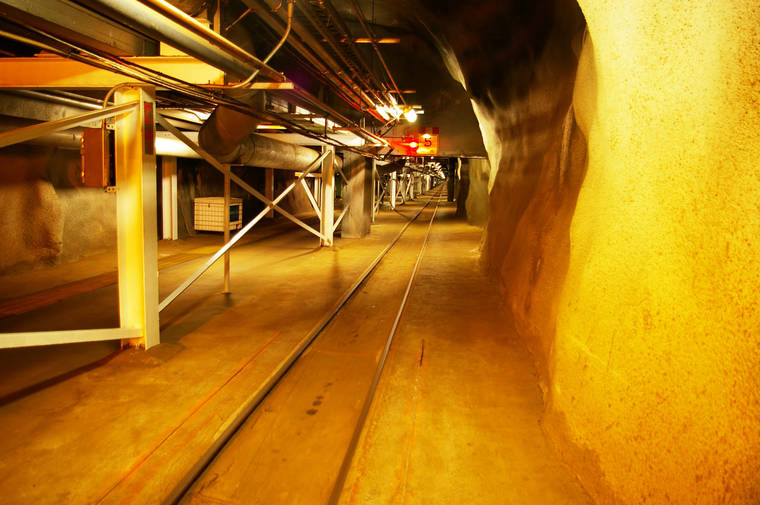State environmental regulators said this week that the Navy has not proved it can safely operate its underground Red Hill fuel tanks, which in recent years have been the subject of mounting concerns over leaks and groundwater contamination.
The conclusion, submitted by the Hawaii Department of Health’s Environmental Health Administration as part of a contested case hearing, raises the possibility that the state might deny the Navy a five-year permit to continue to operating the facility.
“Given the documented history of releases at the site, the uncertainty associated with the Navy’s groundwater model, and the lack of treatment or recovery systems in place to date, the Navy has not met its burden of demonstrating that this facility is protective of human health and the environment from potentially ‘significant’ future releases,” James Paige, a deputy attorney general for the Environmental Health Administration, wrote in the agency’s proposed ruling in the case.
It’s now up to a hearings officer to weigh the positions of the various parties in the case and issue a recommended order. The director of the Department of Health then makes a final decision on the Navy’s permit request, though there is no statutory deadline for doing so.
Typically, directors follow the direction of their own agencies. The Environmental Health Administration said that if a permit is issued for the Red Hill facility it would need to include conditions that would protect against tank erosion, mitigate the uncertainty of the Navy’s own groundwater modeling and address its lack of treatment and recovery systems for spills.
Health Department officials said that they coudn’t say at this time what conditions might satisfy their concerns. But Marti Townsend, director of the Hawaii Sierra Club, which along with the Honolulu Board of Water Supply requested the contested case hearing, said she didn’t think there are permit conditions that can be put in place to address regulators’ concerns about the facility.
“We cannot think of conditions that you could impose now that would make the tanks safe to operate,” she said.
Townsend said the position of state regulators is a positive step in the push to address the threat that Red Hill poses to Oahu’s drinking water supply. While she doubted that it meant the facility was poised to be shut down, she said hopefully it would help fast-track the relocation of the tanks.
The Navy is currently required to do significant upgrades to its World War II-era tanks under an order imposed by federal and state regulators after 27,000 gallons of fuel leaked from one of the tanks in 2014. Tanks that have not been upgraded by 2037 are required to be taken out of service.
Townsend said that’s too long to wait.
“It’s just too dangerous,” she said. “That is part of the reason why we keep pushing.”
Environmentalists, as well as top officials with the Honolulu Board of Water Supply, have expressed alarm since the 2014 spill that a major leak at the facility could contaminate the underground aquifer that serves as a major source of drinking water for Oahu. Each of the 20 Red Hill tanks can hold up to about 12.5 million gallons of fuel. Regulators have said if there is a major release at one of the tanks that contaminates the aquifer, it would be practically impossible to clean up.
The Hawaii Sierra Club successfully sued the state in recent years to force the Health Department to require the Navy to obtain a permit to operate its facility. The Health Department subsequently came close to issuing a permit, but the Sierra Club in 2019 requested a contested case on the permit.
The Navy, in response to this week’s filing, expressed confidence in its ability to obtain a permit for Red Hill and said no further conditions are needed to ensure the facility is safely operated. Lydia Robertson, a spokeswoman for the Navy, described the filing by regulators as “simply a preliminary piece of the hearing process.”
She said that measures already undertaken by the Navy to address concerns following the 2014 leak will protect the environment.
“In almost 80 years of operation, the Red Hill Facility has never posed a threat to human health or the environment,” Robertson said by email. “Past fuel releases, regardless of cause, have never moved beyond the footprint of the facility before diminishing to undetectable levels. No fuel from Red Hill has ever been detected in the drinking water that the Board of Water Supply provides its customers.”
But the Navy’s own documents and reports indicate that over the decades there have been dozens of leaks at the Red Hill facility, which sits just 100 feet above the aquifer and about 2.5 miles from Pearl Harbor. Those leaks, according to the reports, have contaminated the surrounding groundwater and raised internal concerns about the integrity of the aging tanks and their potential to pollute drinking water sources.
Indeed, the Navy’s own 2010 audit Opens in a new tab of the Red Hill facility found that “the environment in the Pearl Harbor area has not been sufficiently protected.”
The Hawaii Sierra Club has estimated that the leaks total more than 178,434 gallons of fuel.
David Kimo Frankel, the Sierra Club’s attorney for the Red Hill case, warned that the threat of a major future release at the facility is significant.
“The Navy’s own documents reveal the significant contamination that has already occurred,” said Frankel in a statement. “Its risk assessment reveals that the probability of a leak up to 30,000 gallons over the next year is 27.6%. Over the next five years, that risk is 80.1% and over the next 10 years that risk is 96.0%.”
Correction: A previous version of this story misstated how much fuel each of the tanks at Red Hill can hold. It’s 12.5 million gallons, not 20 million gallons.

